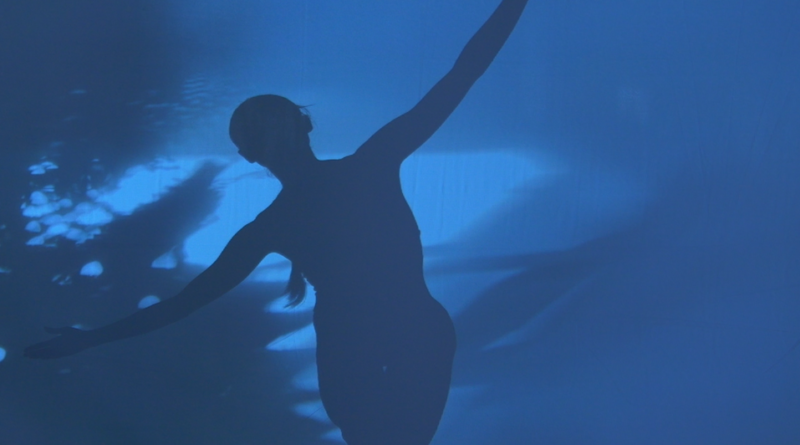INTERVIEW: Judson Memorial Church to host new experimental opera
Photo: Dancer Jin Ju Song-Begin performs in BODY / SHADOW. Photo courtesy of Brice Brown and Steve Gibson / Provided by press rep with permission.
Choreographer Douglas Dunn knows how to collaborate — like, really collaborate. His latest project is called BODY / SHADOW, playing a tragically short run Oct. 27-28 at Judson Memorial Church in New York City. The experimental opera features Dunn’s choreographic moves, coupled with the artistry of his collaborators: composer Paul J. Botelho’s music, Brice Brown’s visual art and Steve Gibson’s media design. Plus, there are 17 dancers helping to bring this shared vision to life.
The piece, which is now sold out for both of its performances, sounds extraordinarily unique. The dancers perform one-minute vignettes that are nonlinear, each exploring the interconnections between the human body and the world of shadows. Dunn is actually in the theater while they are dancing, conducting their many moves while audience members watch the choreographic showcase in the round. Improvisation is the rule of the day, although some parts — such as a five-channel video that is activated from the dancers’ moves — is planned and at the ready. Botelho enjoys the performative nature of the piece as well, circulating amongst his colleagues on stage, vocalizing various parts of the electro-acoustic score, according to press notes.
Recently, to share more news about BODY / SHADOW, Dunn exchanged emails with Hollywood Soapbox. The choreographer has been in the dance business since the late 1960s, according to his official biography. He was a member of the Merce Cunningham Dance Company for years and then served as a founding member of the seminal group Grand Union. Eventually his artistry took him to found Douglas Dunn + Dancers. Questions and answers have been slightly edited for style.
Has it been a welcome challenge choreographing for this experimental opera?
BODY / SHADOW could hardly be more different from my recent piece Garden Party. The latter featured my studio transformed into a verdant grotto by Mimi Gross and lit, equally colorfully and complexly, by Lauren Parish. The scene was seen from one front, so call it a painting; the new, in-the-round piece, call it sculpture. Different approaches is what I like. In this case, the overall idea originated with Brice Brown. Working the dancing to fit his vision has led me with pleasure to new steps and configurations.
What exactly will we see the 17 dancers performing? Are there many solo pieces or full-company numbers?
BODY / SHADOW is excitingly different for me because it is in the round. The circle we dance in is divided into triangles radiating from the center of the sanctuary of Judson Memorial Church. Each of the five triangles has a home trio with its own score of solos and trios, but then the trios migrate clockwise, putting the circle into merry-go-round motion. Projectors on the edge of the circle, one for each triangle, project video onto the dancers and onto screens they hold up. The result is a disappearing of the dancers into shadows. To add to the confusion, the composer/musician Paul Botelho wanders the space, breaking its geometry and making mischief. Two devilish trickster characters, likewise, have inalienable rights as interrupters and rude interpreters. Audience is encouraged to leave their seats and wander about. They will look — in vain — for the ideal view.
And you are present each night to “conduct” the dancers as well?
The dancers have devices [in which] they are able to hear me. I’m in the balcony of the church able to direct them. They know their steps. My instructions have to do with overall changes of space, the large-scale rhythm of the event. This is the first evening-length show I’ve choreographed I’ll not dance in.
What has the experience been like working with your collaborators?
Brice Brown is the instigator. From the beginning he saw the piece as in-the-round and with screens to receive projections. Quite a few versions of how we might arrange the space and the dancing came and went. Input from Steve Gibson and Paul Botelho was ongoing. Truly a group effort, each of us pushing the possibilities further. Most satisfying.
You’ve always worked on multifaceted theatrical experiences. What is it about the “multifaceted” quality that you like so much?
Raw dancing in plain light is my life’s love, but working with colleagues opens up what’s possible and brings variety to the dance image. Also, collaborating leads, I constantly discover, to personally meaningful aesthetic friendships.
Is it extra special performing in such an historic space as Judson Church?
I was in college in the early ’60s, so not part of Judson Dance Theater. But since my arrival in NYC in 1968, I have danced at Judson Memorial Church numerous times, including benefit events to raise money for a better floor. That the institution has survived and continued to host physical performance is a cultural blessing. But even without its historical aura, the space itself, its squareness, its high ceilings, its lack of decoration, its “feel,” are ideal for our piece. From the beginning we imagined showing there, nowhere else, and are grateful to have our feet in the door.
By John Soltes / Publisher / John@HollywoodSoapbox.com
BODY / SHADOW, featuring choreography by Douglas Dunn, plays Oct. 27-28 at Judson Memorial Church in New York City. Click here for more information and tickets. As of press time, both nights were sold out.

